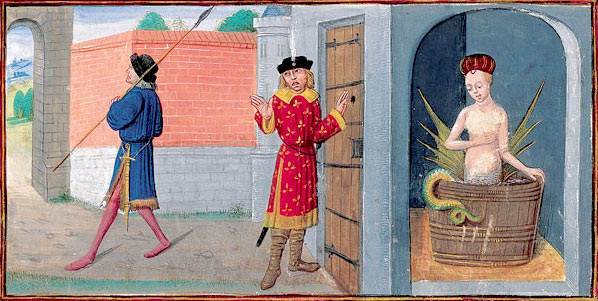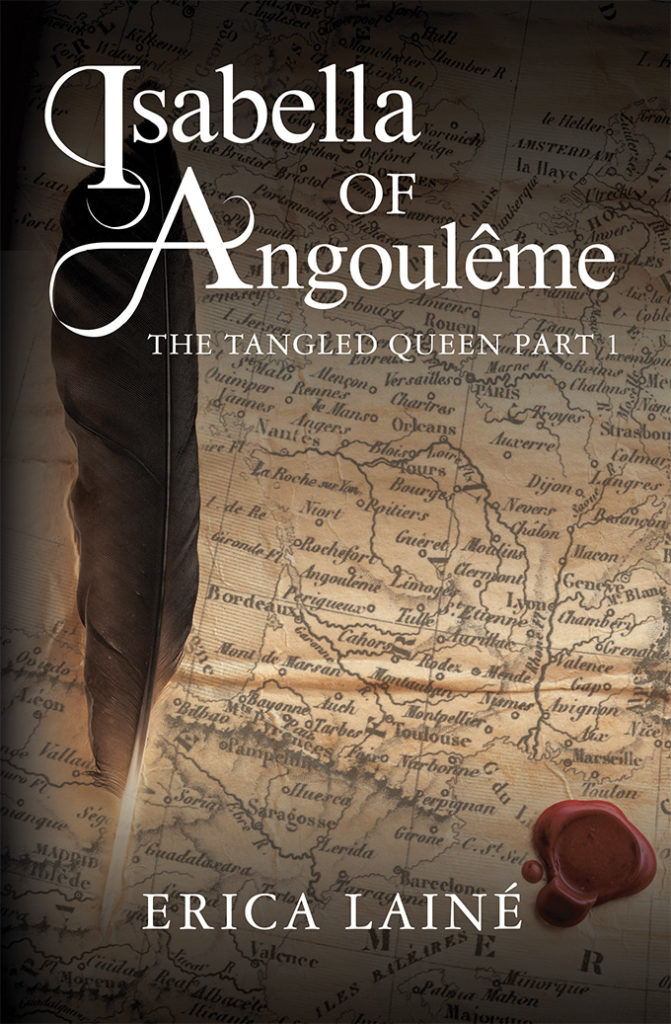
Carving in the church in Lusignan
Isabella married twice and both her husbands belonged to families that believed they were connected to Mélusine, the fairy woman who was beautiful, full of magic and full of mystery. The Angevins, who became known as the Plantagenets, told the story of an early Count Fulk who had a wife who had borne him four sons. Gossip was that she did not go to church that often and when she did refused to take communion. One Sunday her husband snatched her cloak away as she left and she flew out of the window carrying two of the children with her. The two boys left behind carried her demonic blood and so the story of the Devil’s Brood or the Devil’s Crown began. King John was descended from her. The Angevins were certainly linked to a legend of a beautiful and powerful and faery lady. Their fierce tempers and ruthlessness must surely come from her and she must surely come from the Devil. Magic could also explain their rise to power, it was so swift and so comprehensive it could only be unearthly.
Mélusine was seen by many to be an evil presence but for the families who benefitted from her alliances she was a positive force. And she was certainly beneficial to the Lusignans.
Les Très Riches Heures du duc de Berry, March, Lusignan and Mélusine

Isabella’s second husband Hugh Lusignan and his family believed that the castle they lived in had been built for them by Mélusine with ‘a mouthful of water and two handfuls of stones’. She had rescued a Lusignan lost in a nearby forest full of lakes and streams, lurking there with a suspiciously dead uncle. She helped cover up any wrong doing and agreed to marry into the family. Children were born, some with strange defects but all loved. She asked never to be seen in her bath but her husband spied on her and betrayed her and there she was with her serpent tail or mermaid body. So she left, flying high over the castle lamenting and weeping.

In my books, Isabella heard the story of Mélusine in the weaving room for this was a tale told as women spun both threads and tales of magic. She was said to visit the chateau again whenever a child was born.
The Lusignan family were great Crusaders and took the legend with them to Cyprus. Part history, part fantasy, part romance, the name Mélusine could well refer to mère [mother] Lusine and this might have been how the Lusignans acquired their name. Mélusine exists today in a modern logo, that of Starbucks. Look next time at their two tailed mermaid and think about how centuries ago she flew above churches and battlements in Anjou and the Poitou. Not on coffee mugs.

Isabella of Angoulême (The Tangled Queen Part 1)
Set in the thirteenth century, the kingdoms of England and France are struggling over territory as the powerful Angevins threaten the French king. In regions far from Paris local fiefdoms disregard all authority.
The Tangled Queen is the story of the little known and very young Isabella of Angoulême who was abducted by King John in 1200. She became his second wife and queen consort, aged 12. He was the most reviled king in English history and his lust for her led to the loss of Normandy and the destruction of the Plantagenet Empire, which then brought about the Magna Carta.
Isabella came of age in England, but was denied her place in court. Her story is full of thwarted ambition, passion, pride and cruelty. She longed for power of her own and returned to France after the death of John to live a life of treachery and intrigue…
Amazon.com: https://www.amazon.com/Isabella-Angoulême-Tangled-Queen-Book-ebook/dp/B017CA54A6
Amazon UK: https://www.amazon.co.uk/Isabella-Angoulême-Erica-Lainé/dp/1781324573
CONNECT WITH ERICA:
Website: https://ericalainewriter.com/
Twitter: https://twitter.com/LaineEleslaine
Facebook: https://www.facebook.com/ericalaineauthor/?ref=bookmarks